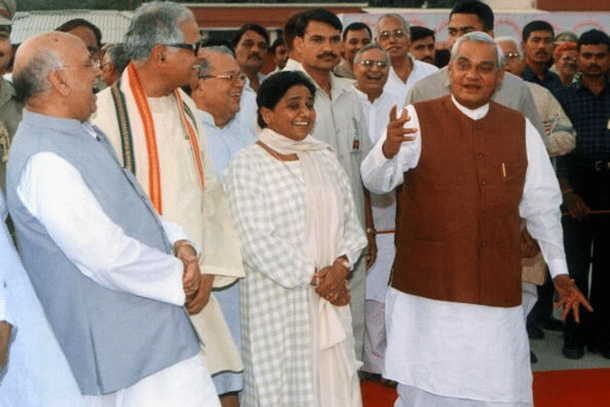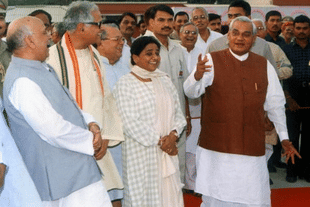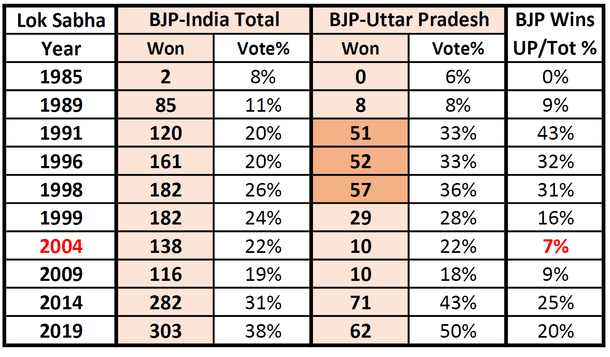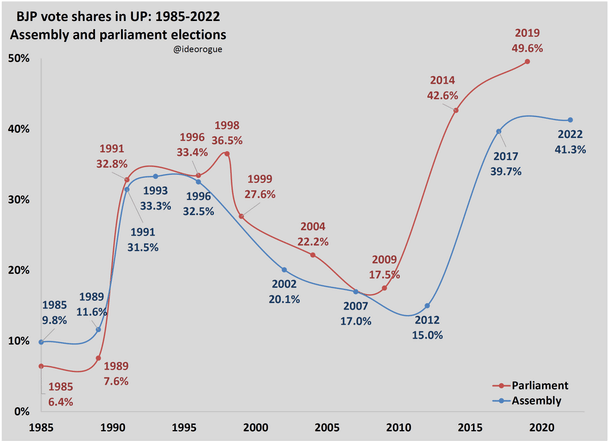Politics
Flashback: The BJP’s 2004 UP Rout Had Its Origins In The Previous Decade
Venu Gopal Narayanan
Mar 23, 2024, 02:59 PM | Updated 02:59 PM IST
Save & read from anywhere!
Bookmark stories for easy access on any device or the Swarajya app.


Three recent opinion polls conducted by leading media houses suggest that the Bharatiya Janata Party (BJP) along with two smaller allies will sweep Uttar Pradesh (UP) in the forthcoming general election.
These polls predict that the BJP will win almost all the 80 seats in the state, with over 50 per cent vote share.
If that happens, it will be the third sweep in a row, reminiscent of the elections of 1991, 1996, and 1998 when the BJP won over 50 seats in the state.

In the table above, the last column on the right shows UP's percentage contribution to the BJP’s national tally.
The results of the 2004 election stand out like a sore thumb. They are paradigmatically significant because the BJP’s shockingly poor performance in India’s largest state that year ended its excellent run at the Centre and allowed the Congress to form a government for 10 long years.
This slump to just 10 wins in UP meant that the Congress became the single-largest party in parliament and, by corollary, the party with a higher chance of forming a government in 2004.
Crushingly for the BJP, the Congress didn’t sweep the state either — they won only nine seats. That glory was reserved for Mulayam Singh Yadav’s Samajwadi Party (SP), which won 35 seats in alliance with the Rashtriya Lok Dal (RLD) of Ajit Singh (who won three), and Mayawati’s Bahujan Samaj Party (BSP), which won 19.
What happened in 2004? Why did the voters reject the BJP so comprehensively and unambiguously that the party lost a significant portion of a valuable vote base it had painstakingly built during the 1990s?
The answer lies within the nature of the BJP’s tremendous rise between 1989 and 1995. Lazy cynics might call it the Vinod Kambli effect, but the truth is more complicated, and has more to do with provincial dynamics than national.
The paradigm point, in this writer’s opinion (and every observer of UP politics has their favourite), was June 1995 when Mayawati withdrew its support to the SP government of Mulayam Singh Yadav to ally with the BJP and become the chief minister in his stead.
Whatever her reasons and rationalisations, this move was seen as a grave betrayal, as the SP and BSP had a pre-poll alliance in the 1993 assembly election to block the BJP out.
An incensed SP unleashed its goonish fury upon Mayawati later that month. This is the notorious ‘guesthouse incident’ where Mayawati was saved by a BJP member of legislative assembly (MLA).
It did nothing to restore political order, so President’s rule was imposed in October 1995. A fresh set of elections the next year didn’t help, since the verdict was a fractured one.
As a result, President’s rule continued until March 1997 when the BSP and BJP entered into an absurd system by which the post of chief minister would rotate between the two parties every six months. This was doomed to fail from the start, yet Mayawati went first.
Unfortunately, these 18 months of President’s rule affected the momentum of the BJP’s ascendancy in UP significantly. This was also the period when the BJP formed a short-lived government at the Centre under Vajpayee's leadership.
In September 1997, it was Kalyan Singh's turn. Unsurprisingly, the BSP withdrew from the alliance. Kalyan Singh's stinging response was to cobble together the numbers by breaking both the BSP and Congress. Some in the BJP were for it, some not.
Note the chronology carefully. The month after this tremendous flux erupted in UP is when BJP ideologue K N Govindacharya reportedly told some foreign journalists that Advani was the real face of the BJP, and that Vajpayee was just a mask.
Word on the street at the time was that this comment had its genesis in a disagreement between Govindacharya and Murli Manohar Joshi on how the party ought to be run. Whatever the truth, in one fell swoop, there was tumult in the BJP at two levels — at the Centre, and in UP, the largest, most politically important province in the country.
This is when a third factor arose within the BJP. While it is true that it had begun as a ‘Brahmin-Baniya’ party, the BJP in UP had commenced a remarkable transition to a far more board-based vote base, with non-dominant Other Backward Castes (OBC) like the Lodhs of Kalyan Singh at the vanguard.
Some of the old guard felt that this transition was edging them out of the power centres. This was an ironic effect since the very objective of the BJP from the start was to aim for a magnificent supra-caste consolidation. But this reaction was also inevitable, since such is human nature. Consequently, the tugs began to tell on Kalyan Singh’s ability to function effectively in office, and on the party’s public standing.
Some commentators, particularly leftist ones, like to describe this period of the late 1990s as a ‘backward-forward tussle’, or more pithily as Mandal-kamandal monkey balancing. The truth is more prosaic: these were the rites of passage any organisation has to endure as it comes of age.
Sadly, the net result is that the BJP’s vote share began to dip alarmingly. As the chart below shows, the BJP peaked in the 1993 assembly election, plateaued for a few years, and then began to decline following its 1995 alliance with the BSP.
The year 1998 was the only good news when the BJP under Vajpayee won over 50 Lok Sabha seats in UP for the third time in a row, and finally managed to form a ‘real’ government at the Centre.

But that victory did nothing to stem the party’s decline in UP and, by corollary, at the national level. The first impact was seen in the 1999 general election when the BJP lost significant numbers of both votes and seats in UP.
To make matters worse, the infighting within the party’s state unit got so bad that Vajpayee was forced to replace Kalyan Singh with R P Gupta — a has-been who had shot his bolt some decades ago.
An incensed Kalyan Singh quit the BJP to start his own party in December 1999. We have two ways of studying this paradigmatic event: as rank disobedience by Kalyan Singh or as a central leadership failure to enforce discipline among those who refused to accept both Kalyan Singh and the transformation he wrought.
Perhaps, it is a bit of both, with the indignant still incapable of condoning Singh’s disobedience (like they view Shankar Singh Vaghela’s 1996 rebellion in Gujarat), and the placatory, proffering justifications for the disaffections of the old guard.
But the point is moot because the damage was already done, collectively, and it showed in the results of the 2002 assembly election in UP. Humiliatingly, the BJP came third behind the SP and the BSP in both seats and vote shares. Kalyan Singh’s new party won four seats.
The hapless BJP was left with little option but to offer its support to Mayawati. But that didn’t last long because, in August 2003, the SP’s Mulayam Singh Yadav split the BSP and became the chief minister. And with that, whatever vestigial advantage that the BJP had also slipped out of its hands.
This was the situation the BJP found itself in as the general election of 2004 approached. In desperation, and to Vajpayee’s credit, they managed to bring Kalyan Singh back into the BJP in January 2004. But it was too little, too late since the SP had already entered into a pre-poll alliance with Ajit Singh’s Jat-based Rashtriya Lok Dal.
That left the BSP and the Congress on their own. And in the messy, quadri-polar polls which ensued, the BJP was all but wiped out of UP. It won only 10 seats, to the Congress’ nine, the BSP’s 19, and the SP-RLD alliance’s 38.
The BJP’s vote share in UP fell to 22 per cent, the lowest since its mercurial ascendancy in 1991, and the state’s contribution of seats to the BJP’s national tally dropped to 7 per cent, the lowest since it first won a seat in UP, in 1989.
Tragically, of a dozen firewall seats which the BJP had won in four consecutive Lok Sabha elections from 1991 to 1999, only four remained in hand when the dust settled.
Both Varanasi and Mathura went to the Congress, as did the spectacular opportunity to form a government at the Centre. Dejected, loyal followers swallowed this defeat with the reassuring thought that 2004 was as bad as it was going to get for the BJP.
However, as the next article in this series will show, they were wrong. It got a whole lot worse.
Venu Gopal Narayanan is an independent upstream petroleum consultant who focuses on energy, geopolitics, current affairs and electoral arithmetic. He tweets at @ideorogue.





